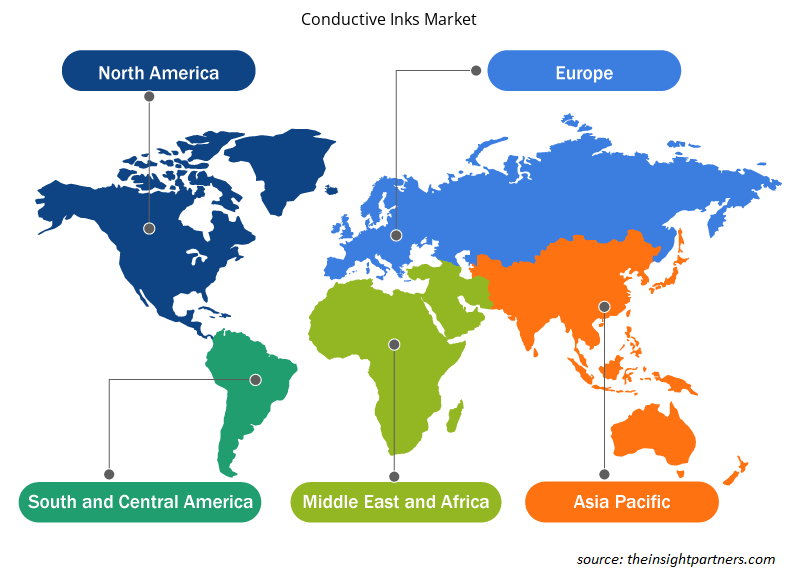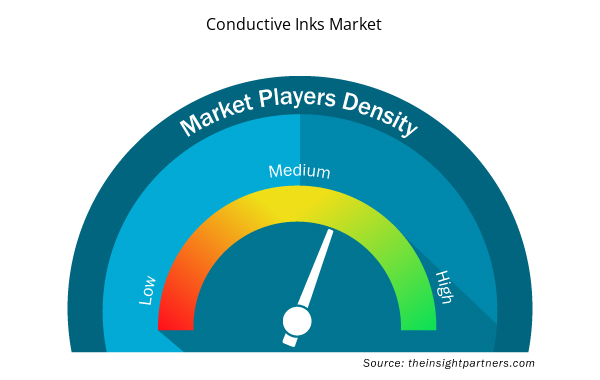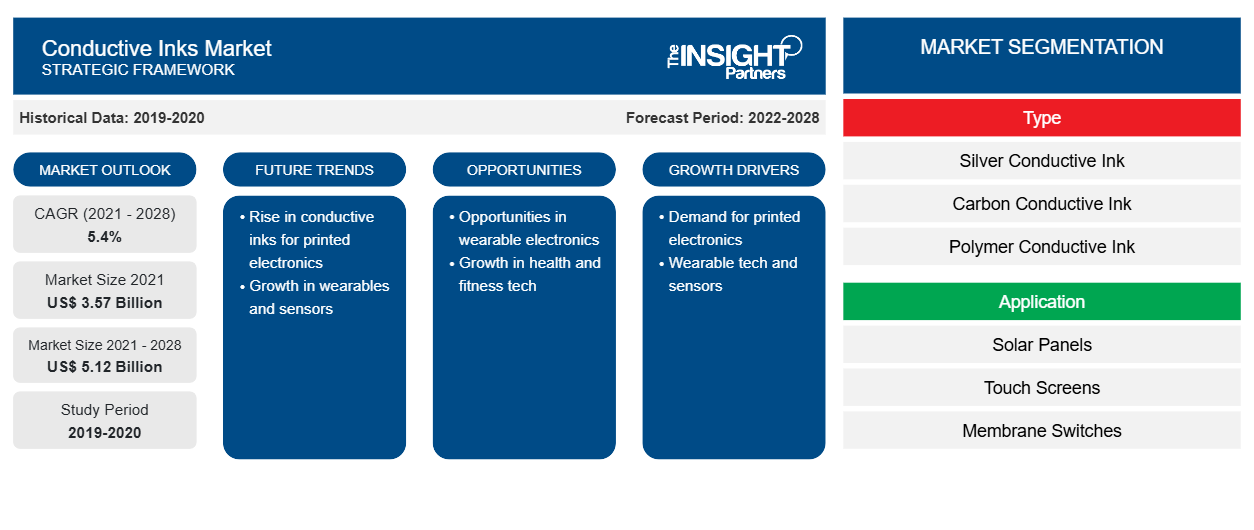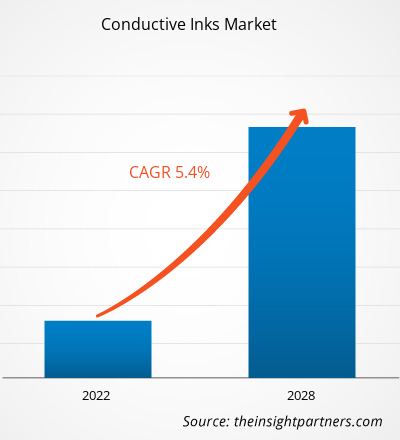[Forschungsbericht] Der Markt für leitfähige Tinten soll von 3.565,80 Millionen US-Dollar im Jahr 2021 auf 5.119,80 Millionen US-Dollar im Jahr 2028 wachsen; von 2022 bis 2028 wird ein durchschnittliches jährliches Wachstum von 5,4 % erwartet.
Regierungen auf der ganzen Welt haben Umweltschutzauflagen erlassen, um die Industrie zu ermutigen, schwere Materialien in Geräten durch moderne, leichte Materialien zu ersetzen. Darüber hinaus hat der Wunsch der Verbraucher nach winziger und leichter Elektronik die Unterhaltungselektronikindustrie dazu veranlasst, ihre Produkte zu miniaturisieren. Darüber hinaus wird erwartet, dass die schnell zunehmende Verbreitung von IoT-basierten Anwendungen und der wachsende Miniaturisierungstrend die Nachfrage nach leitfähigen Tinten ankurbeln werden. Die schnell zunehmende Nutzung von Smartphones und vernetzten Geräten treibt den Bedarf an kleineren und leichteren Sensoren mit geringem Stromverbrauch und verbesserter Leistung voran, was die Nachfrage nach Miniaturisierung ankurbelt. China dominiert die gesamte Wertschöpfungskette der globalen Elektronikfertigung und investiert massiv in neue Techniken, um schnell miniaturisierte Elektronikprodukte herzustellen. Die wachsende Nachfrage nach Miniaturisierung bei Smartphones, Wearables und anderen Gadgets sowie der Anstieg der Nachfrage nach effizienten elektronischen Geräten stärken daher den Markt für leitfähige Tinten .
Passen Sie diesen Bericht Ihren Anforderungen an
Sie erhalten kostenlos individuelle Anpassungen an jedem Bericht, einschließlich Teilen dieses Berichts oder einer Analyse auf Länderebene, eines Excel-Datenpakets sowie tolle Angebote und Rabatte für Start-ups und Universitäten.
- Holen Sie sich die wichtigsten Markttrends aus diesem Bericht.Dieses KOSTENLOSE Beispiel umfasst eine Datenanalyse von Markttrends bis hin zu Schätzungen und Prognosen.
Auswirkungen der COVID-19-Pandemie auf den Markt für leitfähige Tinten
Aufgrund der COVID-19-Pandemie litten viele flexible und gedruckte Elektronikindustrien unter Arbeitskräftemangel. Die Nachfrage nach leitfähiger Tinte für gedruckte elektronische Anwendungen, wie z. B. den Druck von RFID-Tags, die in modernen Fahrkarten und Scheibenenteisern in Kraftfahrzeugen verwendet werden, trägt zum Wachstum des Marktes für leitfähige Tinten bei. Darüber hinaus hat sich der Produktionsrückgang in der Automobilindustrie negativ auf den Markt ausgewirkt. Laut der Internationalen Organisation der Kraftfahrzeughersteller (OICA) betrugen die weltweiten Verkäufe aller Fahrzeuge in den Jahren 2019 und 2020 91.227.182 bzw. 78.774.320. Der Rückgang der Fahrzeugverkäufe wirkt sich daher negativ auf den Markt aus, da leitfähige Tinte für die Anwendung von Automobilschaltkreisen und gedruckten Entfrostern, insbesondere an Heckscheiben, in Kraftfahrzeugen verwendet wird. Ab Mitte 2021 treibt jedoch die Wiederaufnahme von Ölförderungsprojekten das Wachstum des Marktes für leitfähige Tinten an. Vor der Pandemie trieben jedoch die wachsende Automobilindustrie in Nordamerika, die zunehmende Verbreitung von Elektrofahrzeugen und das zunehmende Gesundheitsbewusstsein die Nachfrage nach Miniaturisierung von Geräten voran. Die Unterhaltungselektronikbranche verzeichnet ein Wachstum. Auch die steigende Nachfrage nach kleinen und leichten elektronischen Geräten wie tragbaren Sportuhren und elektronischen medizinischen Geräten zur Gesundheitsüberwachung fördert das Wachstum des Marktes für leitfähige Tinten.
Markteinblicke – Markt für leitfähige Tinten
Zunehmende Installation von Solarmodulen treibt Wachstum auf dem Markt für leitfähige Tinten voran
Der steigende Energiebedarf erfordert die Nutzung alternativer Energiequellen. Daher werden heute erneuerbare Energiequellen, insbesondere Solarenergie, zur Stromerzeugung genutzt. Die zunehmende Nutzung von Solarenergie zur Stromerzeugung wird voraussichtlich die Nachfrage nach solarbasierter Technologie ankurbeln und in den kommenden Jahren den Einsatz von Solarmodulen steigern. Dies wird eine Chance für den Markt für leitfähige Tinten in der Photovoltaik schaffen. Mithilfe von Tintenstrahldruck werden mit leitfähiger Tinte organische Photovoltaik-Solarzellenmodule auf sehr dünne, flexible Oberflächen gedruckt. Der Solarsektor (Photovoltaik) steht unter erheblichem Druck, die Rohstoffkosten zu senken und die Produktionseffizienz zu steigern, um mit bestehenden Netzstromsystemen konkurrieren zu können. In diesem Fall sind leitfähige Tinten eine potenzielle Lösung für die Branche und treiben somit den Markt für leitfähige Tinten an.
Typbasierte Erkenntnisse
Der Markt für leitfähige Tinten ist nach Typ in leitfähige Silbertinte, leitfähige Kohlenstofftinte, leitfähige Polymertinte, leitfähige Kupfertinte und andere unterteilt. Das Segment der leitfähigen Kohlenstofftinte hatte 2021 den größten Marktanteil. Leitfähige Kohlenstofftinten sind gleitfähig, bieten geringe Reibung und ausgezeichnete thermische Stabilität. Die Tinten werden beim Siebdruck, Tauchen und Spritzendispensieren verwendet und zeichnen sich durch ausgezeichnete Haftung auf Glas und einer Vielzahl anderer Substrate aus. Im Gegensatz zu herkömmlichen leitfähigen Materialien sind Kohlenstofftinten abrieb-, kratz-, biege- und knitterfest. Die Entwicklung leitfähiger Tinten wurde durch das schnelle Wachstum des Sektors für gedruckte Elektronik unterstützt. Die leitfähigen Füllstoffe kohlenstoffbasierter leitfähiger Tinten waren weit verbreitet, günstig, gut stabil und hatten einen hohen Anwendungswert. Nanoshel LLC, Henkel und Dycotec Materials Ltd gehören zu den Hauptakteuren auf dem Markt für leitfähige Kohlenstofftinten. Die Präsenz dieser Akteure trägt zum Marktwachstum bei.
Die auf dem Markt für leitfähige Tinten tätigen Akteure konzentrieren sich hauptsächlich auf die Entwicklung fortschrittlicher und effizienter Produkte.
- Im Jahr 2022 kündigte der Geschäftsbereich Microcircuit and Component Materials von DuPont die Einführung von 5881 an, einer neuen leitfähigen Tinte/Paste auf Silber-/Silberchloridbasis für Anwendungen im Gesundheitswesen.
- Im Jahr 2021 gab DuPont den erfolgreichen Abschluss der Übernahme von Laird Performance Materials bekannt, einem weltweit führenden Anbieter von hochleistungsfähigen Lösungen zur elektromagnetischen Abschirmung und zum Wärmemanagement.
Regionale Einblicke in den Markt für leitfähige Tinten
Die regionalen Trends und Faktoren, die den Markt für leitfähige Tinten während des Prognosezeitraums beeinflussen, wurden von den Analysten von Insight Partners ausführlich erläutert. In diesem Abschnitt werden auch die Marktsegmente und die Geografie für leitfähige Tinten in Nordamerika, Europa, im asiatisch-pazifischen Raum, im Nahen Osten und Afrika sowie in Süd- und Mittelamerika erörtert.

- Erhalten Sie regionale Daten zum Markt für leitfähige Tinten
Umfang des Marktberichts über leitfähige Tinten
| Berichtsattribut | Details |
|---|---|
| Marktgröße im Jahr 2021 | 3,57 Milliarden US-Dollar |
| Marktgröße bis 2028 | 5,12 Milliarden US-Dollar |
| Globale CAGR (2021 - 2028) | 5,4 % |
| Historische Daten | 2019-2020 |
| Prognosezeitraum | 2022–2028 |
| Abgedeckte Segmente | Nach Typ
|
| Abgedeckte Regionen und Länder | Nordamerika
|
| Marktführer und wichtige Unternehmensprofile |
|
Marktteilnehmerdichte: Der Einfluss auf die Geschäftsdynamik
Der Markt für leitfähige Tinten wächst rasant, angetrieben durch die steigende Nachfrage der Endverbraucher aufgrund von Faktoren wie sich entwickelnden Verbraucherpräferenzen, technologischen Fortschritten und einem größeren Bewusstsein für die Vorteile des Produkts. Mit steigender Nachfrage erweitern Unternehmen ihr Angebot, entwickeln Innovationen, um die Bedürfnisse der Verbraucher zu erfüllen, und nutzen neue Trends, was das Marktwachstum weiter ankurbelt.
Die Marktteilnehmerdichte bezieht sich auf die Verteilung der Firmen oder Unternehmen, die in einem bestimmten Markt oder einer bestimmten Branche tätig sind. Sie gibt an, wie viele Wettbewerber (Marktteilnehmer) in einem bestimmten Marktraum im Verhältnis zu seiner Größe oder seinem gesamten Marktwert präsent sind.
Die wichtigsten auf dem Markt für leitfähige Tinten tätigen Unternehmen sind:
- Molex
- DuPont
- Henkel AG & Co. KGaA
- Inkron (Nagase-Gruppe)
- InkTec
Haftungsausschluss : Die oben aufgeführten Unternehmen sind nicht in einer bestimmten Reihenfolge aufgeführt.

- Überblick über die wichtigsten Akteure auf dem Markt für leitfähige Tinten
Der Markt für leitfähige Tinten ist nach Typ und Anwendung segmentiert. Nach Typ ist der Markt in Silberleittinte, Kohlenstoffleittinte, Polymerleittinte, Kupferleittinte und andere segmentiert. Im Jahr 2021 war das Segment Kohlenstoffleittinte marktführend und hatte den größten Marktanteil. In Bezug auf die Anwendung ist der Markt in Solarmodule, Touchscreens, Membranschalter, medizinische Geräte, Leiterplatten, Sensoren, Heizelemente, Funkfrequenzidentifikation, Handyantennen, Automobil und andere segmentiert. Im Jahr 2021 war das Segment Leiterplatten marktführend und hatte den größten Marktanteil. Geografisch ist der Markt für leitfähige Tinten grob in Nordamerika, Europa, Asien-Pazifik (APAC), Naher Osten und Afrika (MEA) und Südamerika (SAM) segmentiert. Im Jahr 2021 hatte APAC einen erheblichen Anteil am Weltmarkt.
Zu den wichtigsten Unternehmen auf dem Markt für leitfähige Tinten zählen Applied Ink Solutions, DuPont DE Nemours, Inc., Henkel AG und CO. KGAA, Inkron OY, Inktec, Heraeus, Novacentrix, POLY-INK, Merck KGAA und Vorbeck Materials Corporation.
- Historische Analyse (2 Jahre), Basisjahr, Prognose (7 Jahre) mit CAGR
- PEST- und SWOT-Analyse
- Marktgröße Wert/Volumen – Global, Regional, Land
- Branche und Wettbewerbsumfeld
- Excel-Datensatz



Report Coverage
Revenue forecast, Company Analysis, Industry landscape, Growth factors, and Trends

Segment Covered
This text is related
to segments covered.

Regional Scope
North America, Europe, Asia Pacific, Middle East & Africa, South & Central America

Country Scope
This text is related
to country scope.
Häufig gestellte Fragen
The top five key players operating in the conductive inks markets Dupont de Nemours, Inc., Henkel AG & Co. KGaA, NovaCentrix, MERCK KGaA, and Heraeus Holding GmbH are among the key players profiled in the research study on the conductive inks market. The companies engage themselves in designing and developing conductive inks with competitive pricing which enables the manufacturers to attract customers, thereby, gaining market share
Based on application, the conductive inks market is segmented into solar panels, touch screens, membrane switches, medical devices, printed circuit boards, sensors, heating elements, radio frequency identification, cell phone antennas, automotive glass, etc. The printed circuit board segment accounted for the largest share in the conductive inks market in 2021. A printed circuit board is a rigid structure that contains an electrical circuit made of embedded metal wires called traces and larger areas of metal called planes. The high-performance conductive inks and adhesive materials can withstand high-temperature processing used in the manufacture of printed circuit boards and are contributing to the market growth.
Based on type, the conductive ink market is segmented into silver conductive ink, carbon conductive ink, polymer conductive ink, copper conductive ink, and others. The carbon conductive ink segment accounted for a larger share of the conductive ink market in 2021. Carbon conductive inks are lubricious, providing low friction and excellent thermal stability. The development of conductive inks was aided by the rapid growth of the printed electronics sector. Carbon-based conductive inks' conductive fillers had a wide supply, low price, good stability, and a lot of application value.
The rising adoption of conductive ink in various applications sectors such as 5G, automotive photovoltaic, power electronics, package-level EMI shielding, In-Mold Electronics, electronic textile and wearable electronics, skin patches, RFID, and others. The automotive industry has been a key target market for conductive ink manufacturers. Printed defrosters, particularly on rear windows, are a typical application. The use of transparent and efficient large-area heating to minimize apparent defroster lines is an important development. In Furthermore, seat heaters are also a notable market with ample upside growth opportunities.
The use of conductive inks in printing RFID chips has several advantages, such as reduced size and fast and efficient production, resulting in low production costs. In addition, the RFID tag's antenna is used to distribute frequency signals and establish a wireless link between the tag and the reader. Traditional antenna manufacturing methods are expensive and have slow production speeds. Also, they pollute the environment. To address these drawbacks, the technology of printing antennas with conductive ink is being used. Thus, the growing adoption of RFID technology drives the conductive inks market growth.
Trends and growth analysis reports related to Electronics and Semiconductor : READ MORE..
The List of Companies - Conductive Inks Market
- Molex
- DuPont
- Henkel AG & Co. KGaA
- Inkron (Nagase Group)
- InkTec
- Heraeus
- NovaCentrix
- Poly-Ink
- Merck KGaA
- Vorbeck Materials Corporation
The Insight Partners performs research in 4 major stages: Data Collection & Secondary Research, Primary Research, Data Analysis and Data Triangulation & Final Review.
- Data Collection and Secondary Research:
As a market research and consulting firm operating from a decade, we have published and advised several client across the globe. First step for any study will start with an assessment of currently available data and insights from existing reports. Further, historical and current market information is collected from Investor Presentations, Annual Reports, SEC Filings, etc., and other information related to company’s performance and market positioning are gathered from Paid Databases (Factiva, Hoovers, and Reuters) and various other publications available in public domain.
Several associations trade associates, technical forums, institutes, societies and organization are accessed to gain technical as well as market related insights through their publications such as research papers, blogs and press releases related to the studies are referred to get cues about the market. Further, white papers, journals, magazines, and other news articles published in last 3 years are scrutinized and analyzed to understand the current market trends.
- Primary Research:
The primarily interview analysis comprise of data obtained from industry participants interview and answers to survey questions gathered by in-house primary team.
For primary research, interviews are conducted with industry experts/CEOs/Marketing Managers/VPs/Subject Matter Experts from both demand and supply side to get a 360-degree view of the market. The primary team conducts several interviews based on the complexity of the markets to understand the various market trends and dynamics which makes research more credible and precise.
A typical research interview fulfils the following functions:
- Provides first-hand information on the market size, market trends, growth trends, competitive landscape, and outlook
- Validates and strengthens in-house secondary research findings
- Develops the analysis team’s expertise and market understanding
Primary research involves email interactions and telephone interviews for each market, category, segment, and sub-segment across geographies. The participants who typically take part in such a process include, but are not limited to:
- Industry participants: VPs, business development managers, market intelligence managers and national sales managers
- Outside experts: Valuation experts, research analysts and key opinion leaders specializing in the electronics and semiconductor industry.
Below is the breakup of our primary respondents by company, designation, and region:

Once we receive the confirmation from primary research sources or primary respondents, we finalize the base year market estimation and forecast the data as per the macroeconomic and microeconomic factors assessed during data collection.
- Data Analysis:
Once data is validated through both secondary as well as primary respondents, we finalize the market estimations by hypothesis formulation and factor analysis at regional and country level.
- Macro-Economic Factor Analysis:
We analyse macroeconomic indicators such the gross domestic product (GDP), increase in the demand for goods and services across industries, technological advancement, regional economic growth, governmental policies, the influence of COVID-19, PEST analysis, and other aspects. This analysis aids in setting benchmarks for various nations/regions and approximating market splits. Additionally, the general trend of the aforementioned components aid in determining the market's development possibilities.
- Country Level Data:
Various factors that are especially aligned to the country are taken into account to determine the market size for a certain area and country, including the presence of vendors, such as headquarters and offices, the country's GDP, demand patterns, and industry growth. To comprehend the market dynamics for the nation, a number of growth variables, inhibitors, application areas, and current market trends are researched. The aforementioned elements aid in determining the country's overall market's growth potential.
- Company Profile:
The “Table of Contents” is formulated by listing and analyzing more than 25 - 30 companies operating in the market ecosystem across geographies. However, we profile only 10 companies as a standard practice in our syndicate reports. These 10 companies comprise leading, emerging, and regional players. Nonetheless, our analysis is not restricted to the 10 listed companies, we also analyze other companies present in the market to develop a holistic view and understand the prevailing trends. The “Company Profiles” section in the report covers key facts, business description, products & services, financial information, SWOT analysis, and key developments. The financial information presented is extracted from the annual reports and official documents of the publicly listed companies. Upon collecting the information for the sections of respective companies, we verify them via various primary sources and then compile the data in respective company profiles. The company level information helps us in deriving the base number as well as in forecasting the market size.
- Developing Base Number:
Aggregation of sales statistics (2020-2022) and macro-economic factor, and other secondary and primary research insights are utilized to arrive at base number and related market shares for 2022. The data gaps are identified in this step and relevant market data is analyzed, collected from paid primary interviews or databases. On finalizing the base year market size, forecasts are developed on the basis of macro-economic, industry and market growth factors and company level analysis.
- Data Triangulation and Final Review:
The market findings and base year market size calculations are validated from supply as well as demand side. Demand side validations are based on macro-economic factor analysis and benchmarks for respective regions and countries. In case of supply side validations, revenues of major companies are estimated (in case not available) based on industry benchmark, approximate number of employees, product portfolio, and primary interviews revenues are gathered. Further revenue from target product/service segment is assessed to avoid overshooting of market statistics. In case of heavy deviations between supply and demand side values, all thes steps are repeated to achieve synchronization.
We follow an iterative model, wherein we share our research findings with Subject Matter Experts (SME’s) and Key Opinion Leaders (KOLs) until consensus view of the market is not formulated – this model negates any drastic deviation in the opinions of experts. Only validated and universally acceptable research findings are quoted in our reports.
We have important check points that we use to validate our research findings – which we call – data triangulation, where we validate the information, we generate from secondary sources with primary interviews and then we re-validate with our internal data bases and Subject matter experts. This comprehensive model enables us to deliver high quality, reliable data in shortest possible time.


 Holen Sie sich ein kostenloses Muster für diesen Bericht
Holen Sie sich ein kostenloses Muster für diesen Bericht